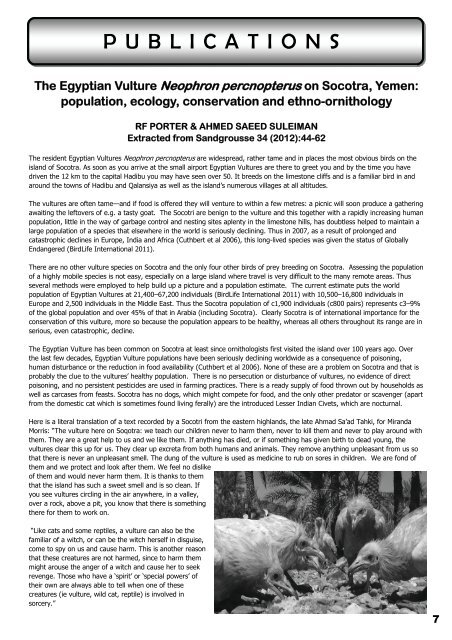TAYF the Soqotra Newsletter - Friends of Soqotra
TAYF the Soqotra Newsletter - Friends of Soqotra
TAYF the Soqotra Newsletter - Friends of Soqotra
Create successful ePaper yourself
Turn your PDF publications into a flip-book with our unique Google optimized e-Paper software.
PUBLICATIONS<br />
The Egyptian Vulture Neophron percnopterus on Socotra, Yemen:<br />
population, ecology, conservation and ethno-ornithology<br />
RF PORTER & AHMED SAEED SULEIMAN<br />
Extracted from Sandgrousse 34 (2012):44-62<br />
The resident Egyptian Vultures Neophron percnopterus are widespread, ra<strong>the</strong>r tame and in places <strong>the</strong> most obvious birds on <strong>the</strong><br />
island <strong>of</strong> Socotra. As soon as you arrive at <strong>the</strong> small airport Egyptian Vultures are <strong>the</strong>re to greet you and by <strong>the</strong> time you have<br />
driven <strong>the</strong> 12 km to <strong>the</strong> capital Hadibu you may have seen over 50. It breeds on <strong>the</strong> limestone cliffs and is a familiar bird in and<br />
around <strong>the</strong> towns <strong>of</strong> Hadibu and Qalansiya as well as <strong>the</strong> island’s numerous villages at all altitudes.<br />
The vultures are <strong>of</strong>ten tame—and if food is <strong>of</strong>fered <strong>the</strong>y will venture to within a few metres: a picnic will soon produce a ga<strong>the</strong>ring<br />
awaiting <strong>the</strong> leftovers <strong>of</strong> e.g. a tasty goat. The Socotri are benign to <strong>the</strong> vulture and this toge<strong>the</strong>r with a rapidly increasing human<br />
population, little in <strong>the</strong> way <strong>of</strong> garbage control and nesting sites aplenty in <strong>the</strong> limestone hills, has doubtless helped to maintain a<br />
large population <strong>of</strong> a species that elsewhere in <strong>the</strong> world is seriously declining. Thus in 2007, as a result <strong>of</strong> prolonged and<br />
catastrophic declines in Europe, India and Africa (Cuthbert et al 2006), this long-lived species was given <strong>the</strong> status <strong>of</strong> Globally<br />
Endangered (BirdLife International 2011).<br />
There are no o<strong>the</strong>r vulture species on Socotra and <strong>the</strong> only four o<strong>the</strong>r birds <strong>of</strong> prey breeding on Socotra. Assessing <strong>the</strong> population<br />
<strong>of</strong> a highly mobile species is not easy, especially on a large island where travel is very difficult to <strong>the</strong> many remote areas. Thus<br />
several methods were employed to help build up a picture and a population estimate. The current estimate puts <strong>the</strong> world<br />
population <strong>of</strong> Egyptian Vultures at 21,400–67,200 individuals (BirdLife International 2011) with 10,500–16,800 individuals in<br />
Europe and 2,500 individuals in <strong>the</strong> Middle East. Thus <strong>the</strong> Socotra population <strong>of</strong> c1,900 individuals (c800 pairs) represents c3–9%<br />
<strong>of</strong> <strong>the</strong> global population and over 45% <strong>of</strong> that in Arabia (including Socotra). Clearly Socotra is <strong>of</strong> international importance for <strong>the</strong><br />
conservation <strong>of</strong> this vulture, more so because <strong>the</strong> population appears to be healthy, whereas all o<strong>the</strong>rs throughout its range are in<br />
serious, even catastrophic, decline.<br />
The Egyptian Vulture has been common on Socotra at least since ornithologists first visited <strong>the</strong> island over 100 years ago. Over<br />
<strong>the</strong> last few decades, Egyptian Vulture populations have been seriously declining worldwide as a consequence <strong>of</strong> poisoning,<br />
human disturbance or <strong>the</strong> reduction in food availability (Cuthbert et al 2006). None <strong>of</strong> <strong>the</strong>se are a problem on Socotra and that is<br />
probably <strong>the</strong> clue to <strong>the</strong> vultures’ healthy population. There is no persecution or disturbance <strong>of</strong> vultures, no evidence <strong>of</strong> direct<br />
poisoning, and no persistent pesticides are used in farming practices. There is a ready supply <strong>of</strong> food thrown out by households as<br />
well as carcases from feasts. Socotra has no dogs, which might compete for food, and <strong>the</strong> only o<strong>the</strong>r predator or scavenger (apart<br />
from <strong>the</strong> domestic cat which is sometimes found living ferally) are <strong>the</strong> introduced Lesser Indian Civets, which are nocturnal.<br />
Here is a literal translation <strong>of</strong> a text recorded by a Socotri from <strong>the</strong> eastern highlands, <strong>the</strong> late Ahmad Sa’ad Tahki, for Miranda<br />
Morris: “The vulture here on <strong>Soqotra</strong>: we teach our children never to harm <strong>the</strong>m, never to kill <strong>the</strong>m and never to play around with<br />
<strong>the</strong>m. They are a great help to us and we like <strong>the</strong>m. If anything has died, or if something has given birth to dead young, <strong>the</strong><br />
vultures clear this up for us. They clear up excreta from both humans and animals. They remove anything unpleasant from us so<br />
that <strong>the</strong>re is never an unpleasant smell. The dung <strong>of</strong> <strong>the</strong> vulture is used as medicine to rub on sores in children. We are fond <strong>of</strong><br />
<strong>the</strong>m and we protect and look after <strong>the</strong>m. We feel no dislike<br />
<strong>of</strong> <strong>the</strong>m and would never harm <strong>the</strong>m. It is thanks to <strong>the</strong>m<br />
that <strong>the</strong> island has such a sweet smell and is so clean. If<br />
you see vultures circling in <strong>the</strong> air anywhere, in a valley,<br />
over a rock, above a pit, you know that <strong>the</strong>re is something<br />
<strong>the</strong>re for <strong>the</strong>m to work on.<br />
“Like cats and some reptiles, a vulture can also be <strong>the</strong><br />
familiar <strong>of</strong> a witch, or can be <strong>the</strong> witch herself in disguise,<br />
come to spy on us and cause harm. This is ano<strong>the</strong>r reason<br />
that <strong>the</strong>se creatures are not harmed, since to harm <strong>the</strong>m<br />
might arouse <strong>the</strong> anger <strong>of</strong> a witch and cause her to seek<br />
revenge. Those who have a ‘spirit’ or ‘special powers’ <strong>of</strong><br />
<strong>the</strong>ir own are always able to tell when one <strong>of</strong> <strong>the</strong>se<br />
creatures (ie vulture, wild cat, reptile) is involved in<br />
sorcery.”<br />
7


